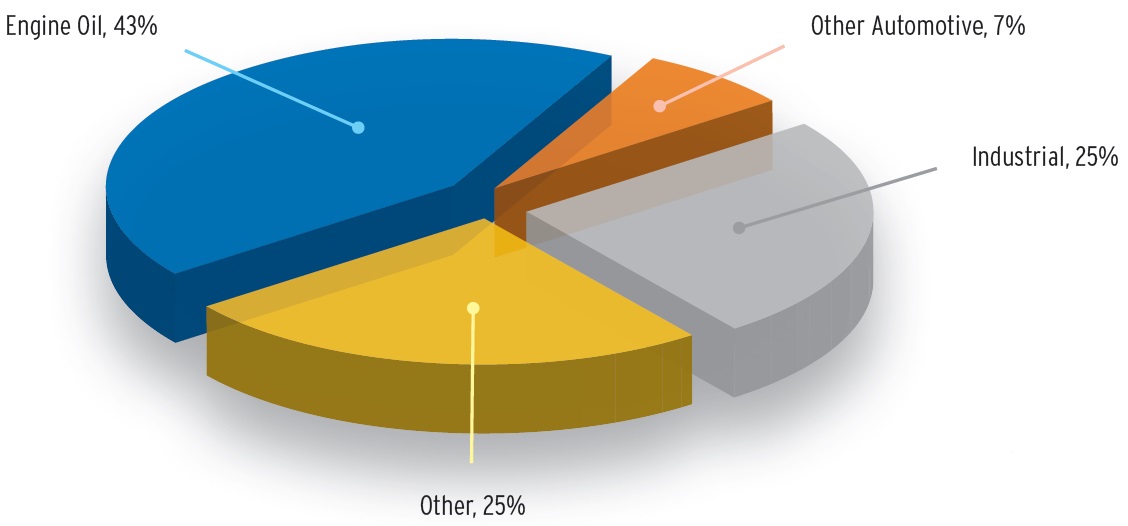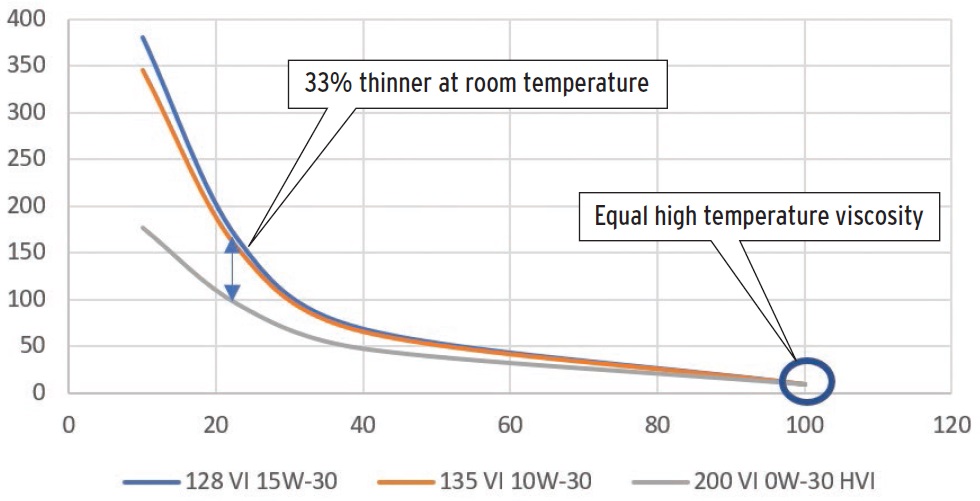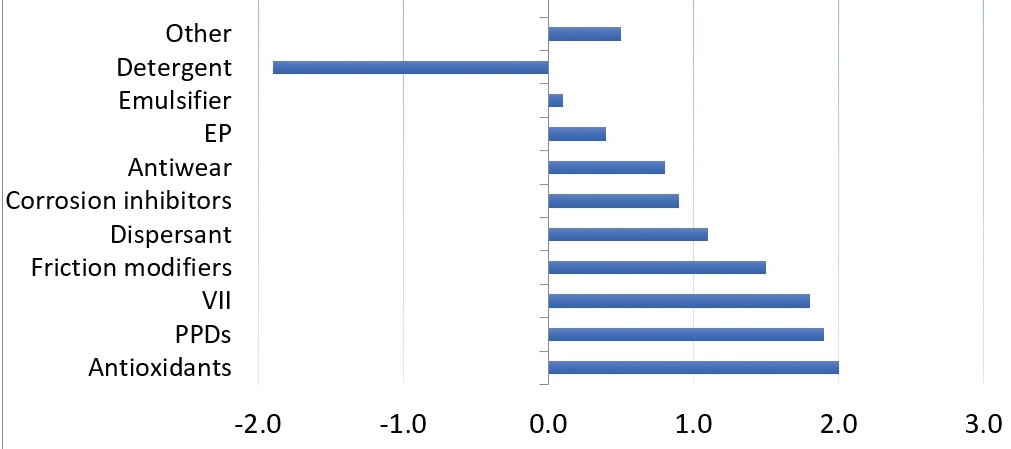The potential of energy-efficient lubricants
David Tsui | TLT Market Trends February 2018
Advances in additive technology are reducing the world’s carbon footprint and creating a more sustainable future.

© Can Stock Photo / mtoome
KEY CONCEPTS
•
Additives often are overlooked for their efficiency potential because lubricants tend to be identified by their base oil.
•
The benefits of high-VI lubricants will only increase as we continue to rely on hybrid and electric vehicles to meet future fuel economy standards.
•
The use of friction modifiers in all end-use categories is expected to increase, with growth in PCMO particularly strong.
WITH LUBRICANT MARKET GROWTH FLATTENING, lube marketers need to identify new markets to promote lubricant usage. The energy-efficient lubricant is a viable segment that can be promoted to help reduce our carbon footprint and conserve resources.
The contribution from lubricants in improving energy efficiency, reducing our carbon footprint and controlling greenhouse gas (GHG) is often overlooked. Lubricants and lubricant additives can help reduce our CO
2 footprint and control GHG emissions as we strive toward a more renewable future. Automotive engine oil and fuel economy usually comes to mind first, as this has been the focus of many government regulations from CAFE to Euro 6 to National VI. Yet the transportation sector only makes up a part of global energy consumption. The industrial sector consumes around a quarter of the overall lubricant demand, leaving a large sector that can adopt more energy-efficient lubricants (
see Figure 1).
 Figure 1. The overall lubricant demand of 2017. The Other category includes MWFs, process oils and grease. (Source: Kline Global Lubricant Additives, fifth edition.)
Figure 1. The overall lubricant demand of 2017. The Other category includes MWFs, process oils and grease. (Source: Kline Global Lubricant Additives, fifth edition.)
Automotive engine oils typically can generate a few percent fuel economy savings by switching to the next lower viscosity grade, and many experts tend to believe a lubricant can only improve efficiency by a percent or two. Lubricants and the additives that go into them can actually contribute a much greater efficiency gain than consumers realize. In PCMO for instance, downsized GDI (gasoline direct injection) engines with turbochargers have a potential for 15%-20% fuel economy gain but only when paired with a modern engine oil engineered to protect these new engines.
Additives can make up from 0.5%-25% of the lubricant, with the remainder composed of a base oil, yet the additive contribution often goes unnoticed as lubricants have been traditionally identified by their base oil type such as conventional, synthetic or blend. The additives used in lubricants can help improve efficiency by several means.
•
Chemistry/formulation
•
Friction reduction
•
Viscosity index
•
Lubricant longevity
•
Equipment life/protection.
The chemistry of lubricant additives and the specific blend of these components in a fully formulated lubricant can enable OEMs to extract the highest potential out of their equipment. Automotive OEMs have been downsizing engines for fuel economy benefits, and while these smaller engines can be 20% more efficient, they are not small in power. With GDI and turbocharging, these engines can put out the power of an engine more than double their size.
As the power density continues to increase, modern engines become prone to a phenomenon called low speed pre-ignition (LSPI). LSPI is an abnormal combustion event (similar to engine knock) in which a phenomenon causes off-cycle ignition of the fuel-air mixture, which leads to excessive pressure in the cylinder. In mild cases this causes rough running and lower fuel economy/power, but in more severe cases this can actually cause catastrophic engine failure. Additive companies and OEMs have worked together to develop the next generation of engine oils that control LSPI and allow these modern engines to live up to their full potential. This has been done through a careful rebalancing of detergent chemistries used in the engine oil formulation to prevent LSPI.
One of the main roles of a lubricant is reducing friction between moving parts. Friction modifiers can play a significant role in reducing that dynamic friction, and Kline forecasts growth in friction modifier use in all end-use categories, although growth in PCMO will be particularly strong.
The viscosity index (VI) of a lubricant indicates the change in viscosity with regards to temperature, with higher numbers indicating lower change. Viscosity index improvers (VIIs) or viscosity modifiers (VMs) are additives that help increase the VI of a lubricant. What this means is an oil with a higher VI number (e.g., 200) has a flatter viscosity curve, which translates to a lubricant that doesn’t thicken as much when temperatures drop.
Figure 2 shows three examples. The first two are a 15W-30 with a VI of 128 and a 10W-30 with a VI of 135. The switch from the 15W-30 to a 10W-30 will typically give you a 1% fuel economy improvement as the low-temperature viscosity is now around 10% lower, yet the operating temperature viscosity is equivalent and offers the same high-temperature protection. The third example would be a high VI 0W-30 formulated with a modern VM to reach a 200 VI. This fluid would reduce the low-temperature viscosity 33% more than the 10W-30.
 Figure 2. Three examples of viscosity versus temperature. (Source: 10W-30 and 15W-30 PDS, adjusted for an equal KV100 C, 200 VI lubricant was extrapolated by Kline.)
Figure 2. Three examples of viscosity versus temperature. (Source: 10W-30 and 15W-30 PDS, adjusted for an equal KV100 C, 200 VI lubricant was extrapolated by Kline.)
The efficiency of a high-VI lubricant can benefit any lubricated equipment that cycles on and off and operates under fluctuating temperature conditions—hydraulic equipment, both stationary and off road, gas turbines on planes and for power generation, as well as gear oils used in wind turbines. Evonik, for example, is marketing a line of high-VI hydraulic fluids with guaranteed energy savings of at least 3.5%. Honda also has been working with lubricant blenders on a 200-VI engine oil for its 2018-19 model year vehicles. The benefits of high VI lubricants will only increase as we continue to rely on hybrid and electric vehicles to meet future fuel economy standards.
The combustion engine in a hybrid vehicle may only see short-term service and infrequent use, so those engines will spend more time operating at lower temperatures and may not actually reach operating temperatures during a typical commute. The same trends are seen in a renewable energy power station that has a gas turbine power generator to fill in gaps in power generation. The gas turbines need to quickly cycle on and off to provide a continuous power source. One of the easiest ways to conserve energy is to use energy only when it is needed, which will cause our equipment use to become much more cyclical and drive demand for VM use. High-VI lubricants typically use a lower-viscosity, higher-quality base oil along with additional VM to meet the same high-temperature protection. For example, a 0W-30 will use more VM compared to a 10W-30.
Lubricant longevity also is a source of resource and energy conservation. While most of the increased efficiency will be through a reduction in energy usage, some will come in the form of prolonged service intervals and equipment life. Wind turbines here are a perfect example where traveling to remote wind stations and taking equipment offline to service will waste energy. In this case a very long-life lubricant is the best option for keeping equipment online and generating power. In the case of vehicles and industrial equipment, it translates into less consumption of overall lubricants. This will drive anti-oxidant use in lubricants.
Protecting equipment is a major source of resource conservation, as broken or worn out equipment requires massive amounts of resource to replace. Worn out equipment also tends to operate less efficiently and consume more lubricant volume. As OEMs downsize equipment and increase power output, they will switch to lighter, stronger materials that require the unique protection that only additives can provide. Engine OEMs, for example, are trying diamond-like coatings (DLCs) in their engines, yet have witnessed the DLC layer destroyed with current-generation lubricants. Modern engine oils could include technology from gear oils such as extreme pressure (EP) additives to protect DLCs.
When you look beyond the viscosity benefits of a lighter lubricant, the additives and formulations can contribute much more than the percent or two in efficiency gains typically associated with an incremental drop in viscosity. It will fall to the additive companies and their vast knowledge about additives and tribology to work with OEMs in developing the next generation of additives and formulations that will unlock the potential of future energy efficient lubricants. Kline forecasts strong growth in antioxidants, VIIs and friction modifiers while other additive categories such as detergents and antiwear will see a significant shift in chemistry (
see Figure 3).
 Figure 3. Kline forecasts strong growth in antioxidants, VIIs and friction modifiers while other additive categories such as detergents and antiwear will see a significant shift in chemistry. (Source: Kline Global Lubricant Additives, fifth edition.)
Figure 3. Kline forecasts strong growth in antioxidants, VIIs and friction modifiers while other additive categories such as detergents and antiwear will see a significant shift in chemistry. (Source: Kline Global Lubricant Additives, fifth edition.)
 David Tsui is a Project Manager at Kline & Co. in the Energy practice. You can reach him at david.tsui@klinegroup.com
David Tsui is a Project Manager at Kline & Co. in the Energy practice. You can reach him at david.tsui@klinegroup.com.
Kline is an international provider of world-class consulting services and high-quality market intelligence for industries including lubricants and chemicals. Learn more at www.klinegroup.com.